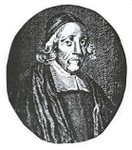Aspects of Piety 08

Style 1b
Angus assembles a host of names from the worlds of literature and divinity that have been linked with Adams. In his youth he was the contemporary of the race that adorned the reign of Elizabeth, – Spenser, Shakespeare and Jonson, Bacon and Raleigh.
Note: Edmund Spenser (1552/3-1559) wrote the long allegorical poem The Faerie Queene. William Shakespeare (1564-1615) and Ben Jonson (1572-1637) were the chief dramatists of their day and accomplished poets. Francis Bacon (1561-1626) lawyer, statesman, philosopher and master of the English tongue, served as Lord Chancellor 1618-21. He is remembered both for his literary and his political skills. Walter Raleigh (1554?-1618) was the enigmatic adventurer and writer and favourite of Elizabeth later accused of treason and executed in James’ reign.
Among the men of his own age were Bishops Hall and Andrewes, Sibbes, author of the Bruised Reed and the Soul’s Conflict, Fuller the historian, and now in the church and now out of it, Hildersham and Byfield and Cartwright.
Note: Joseph Hall (1574-1656) [pic 1] was at the Synod of Dort, 1618, and a bishop by the early 1640s. A moral philosopher and satirist, remarkable for his literary versatility and innovation. He wrote the first English satire successfully based on Latin models and emulated ancient Greek philosopher Theophrastus with Characters upon Vertues and Vices 1608. Adams calls him ‘our worthy divine and best characterer’. Lancelot Andrewes (1555-1626) [pic 2] was a theologian and master of rhetoric. He earned a reputation as an eloquent and learned court preacher, seeking to defend and advance Anglicanism. Both were influenced by Puritanism in early life.
Puritan Richard Sibbes (1577-1635) celebrated in Dever’s book, mentioned elsewhere on this site, Arthur Hildersham (1563-1631), Nicholas Byfield (1579-1622) and Thomas Cartwright (1535-1603) – all popular Puritan authors.
Earle was busy writing and publishing the Microcosmography and Overbury had already issued his Characters. A little before him flourished Arminius and Whitgift, Hooker and Reynolds; and a little after him Hammond and Baxter, Taylor and Barrow, Leighton and Howe.
Note: John Earle (1601?-1665) Bishop of Salisbury in his final years, wrote Microcosmography, a collection of witty characterisations, his best known work, 1628. Thomas Overbury (1581-1613) was an enormously popular poet and essayist. His sketch in verse, A Wife (1614), outlines his idea of the perfect wife. To it he appended over 80 character sketches, ‘a collection marked by its extravagant fancy, pungent wit, and flippant mockery of social folly’ according to Baker. She says ‘One of the most striking literary features of Adams’ sermons is his ubiquitous use of the satiric prose character, a form introduced into English prose by Joseph Hall. … Drawing upon both Hall and the Overburians, Adams shapes characters appropriate to his preaching of conversion.’
Controversial theology professor Jacobus Arminius (1560-1609); Archbishop of Canterbury John Whitgift (1530-1604); architect of Anglicanism, Richard Hooker (1554?-1600) are well known figures. Westminster divine Edward Reynolds (1599-1676) became Bishop of Norwich. Henry Hammond (1605-1660) a Royalist scholar and preacher. Oratory admired by Charles I. Richard Baxter (1615-1691) prolific Puritan writer and activist. Isaac Barrow (1630-1677) mathematician, chaplain to Charles II, controversial writer of weight, chiefly against the papacy. Adams ‘may be fitly compared to Barrow in the thoroughness which exhausts his subjects’ (sic) says Stowell (p xvi). Presbyterian Robert Leighton (1611-1684) celebrated for his commentary on 1 and 2 Peter, was cruelly persecuted for attacking the bishops. John Howe (1630-1705) chaplain to Cromwell, was ejected 1662.







No comments:
Post a Comment